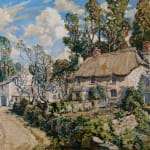Walter Elmer Schofield 1867-1944
Devon Farm
Oil on canvas
40 x 48 inches
101.6 x 121.9 cm
Framed dimensions 52 1/2 x 44 3/4 inches
101.6 x 121.9 cm
Framed dimensions 52 1/2 x 44 3/4 inches
Signed lower right: Schofield
In Devon Farm, Walter Elmer Schofield demonstrates the signature painting style he became best known for. Painted en plein air, the energetic brushwork and thick impasto effectively communicate the rapidity...
In Devon Farm, Walter Elmer Schofield demonstrates the signature painting style he became best known for. Painted en plein air, the energetic brushwork and thick impasto effectively communicate the rapidity with which Schofield painted and the way his technique captured the essence of a place through dazzling juxtapositions between form and light. As a comrade of Edward Redfield, one of the great proponents of plein-air painting, Schofield learned the importance of painting outdoors and made the practice a cornerstone of his artistic method. All of his paintings reveal his keen powers of observation and the uniqueness with which he put what he saw on canvas.
During the first three decades of the twentieth century, Schofield was regarded as one of America’s finest landscape painters. He braved brutal weather conditions to capture the panoramic snow scenes for which he was most acclaimed. Even though Schofield traveled widely, he is credited with being one of the great disseminators of the Pennsylvania School of Impressionism. His compositional style and choice of subject matter are very much in keeping with Edward Redfield’s, the dean of the Pennsylvania School. Yet Schofield took the influence of his mentor and transformed it into something entirely his own. His treatment of light and shadow, broad brushwork, and heavy outlines are some of the finest hallmark’s Schofield’s personal style – all of which are readily apparent here.
Born in Philadelphia, Schofield attended the Pennsylvania Academy of the Fine Arts from 1889 to 1892 and studied under Thomas Anshutz. Afterward he traveled to Paris and enrolled in courses at the Academie Julian from 1892 to 1895. He met Edward Redfield in Robert Henri’s studio and the two enjoyed a close friendship until 1904. Until this point, Schofield’s style was somewhat soft, akin to that of John Twachtman and Fritz Thaulow. The bold, painterly style that Schofield developed in the early part of the 1900s probably owes a good part to the influence of Redfield, who at this time was also painting landscapes in this way.
Schofield would come to be regarded as one of the great American landscape painters of the early twentieth century. His commitment to his artistic method of painting outdoors gave his an authenticity and boldness that won him critical and commercial acclaim.
During the first three decades of the twentieth century, Schofield was regarded as one of America’s finest landscape painters. He braved brutal weather conditions to capture the panoramic snow scenes for which he was most acclaimed. Even though Schofield traveled widely, he is credited with being one of the great disseminators of the Pennsylvania School of Impressionism. His compositional style and choice of subject matter are very much in keeping with Edward Redfield’s, the dean of the Pennsylvania School. Yet Schofield took the influence of his mentor and transformed it into something entirely his own. His treatment of light and shadow, broad brushwork, and heavy outlines are some of the finest hallmark’s Schofield’s personal style – all of which are readily apparent here.
Born in Philadelphia, Schofield attended the Pennsylvania Academy of the Fine Arts from 1889 to 1892 and studied under Thomas Anshutz. Afterward he traveled to Paris and enrolled in courses at the Academie Julian from 1892 to 1895. He met Edward Redfield in Robert Henri’s studio and the two enjoyed a close friendship until 1904. Until this point, Schofield’s style was somewhat soft, akin to that of John Twachtman and Fritz Thaulow. The bold, painterly style that Schofield developed in the early part of the 1900s probably owes a good part to the influence of Redfield, who at this time was also painting landscapes in this way.
Schofield would come to be regarded as one of the great American landscape painters of the early twentieth century. His commitment to his artistic method of painting outdoors gave his an authenticity and boldness that won him critical and commercial acclaim.
Provenance
Private collection, New York, until 2021Please join our mailing list
* denotes required fields
We will process the personal data you have supplied in accordance with our privacy policy (available on request). You can unsubscribe or change your preferences at any time by clicking the link in our emails.



